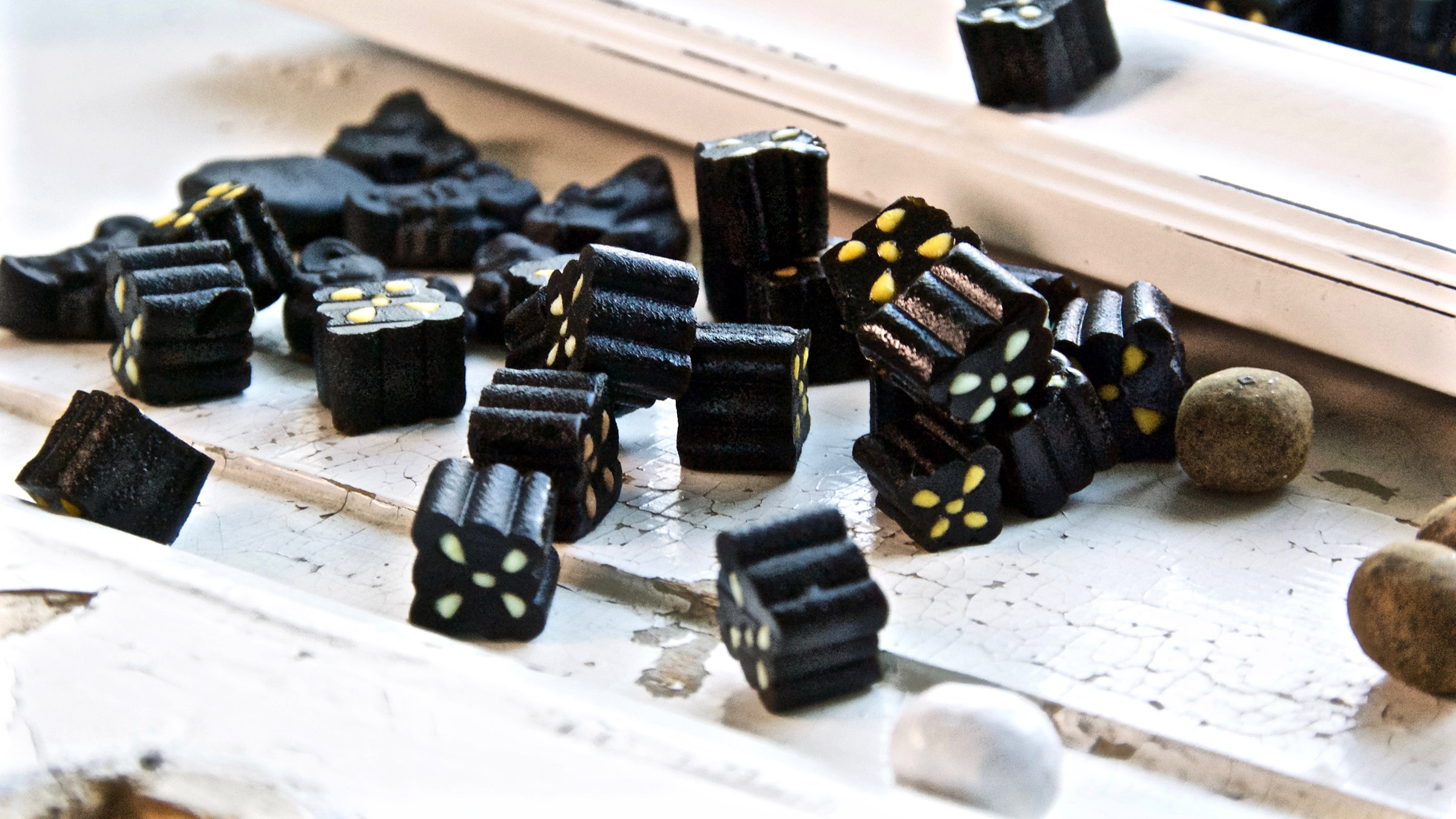In our ‘Matter of Taste’ series, we have delved into a variety of dishes that require a bit of adjusting for unaccustomed taste buds, but nothing has had quite the polarising effect that salty liquorice seems to elicit. The uninitiated tend to react to the curious confectionery on a scale from perplexed to disgusted, while enthusiasts start drooling at the mere sight of the black stuff. To understand why that might be, let’s get to the bottom of this enigmatic treat.
An Intriguing Ingredient
The key component of regular liquorice is an extract made from the roots of the liquorice plant Glycyrrhiza glabra – lending it its characteristic black colour – together with sugar (between 30 and 60%) and a binder, which used to be gum arabic, but is nowadays replaced by cheaper modified starch. Various spices also factor into the recipe. The characteristic liquorice flavour comes from glycyrrhizin, an acid that’s around 50 times sweeter than sugar.
Whereas most black liquorice consumed around the world is typically sweet, the Dutch, German and Scandinavian varieties – the salty kind in question – might also contain salmiac (ammonium chloride, i.e. ammonium salt). Natural sources of this rare mineral include volcanic craters, though it can also be artificially produced by reacting ammonia with hydrochloric acid (how’s that for a yummy food ingredient!). Its flavour isn’t just plain salty; it also has a slight smokiness and even astringence. The curious ingredient is added in various quantities, with the Dutch dubbelzout (‘double salted’), svenskjävlar (‘Swedish bastards’), Icelandic djöflar (‘devils’) or Norwegian dundersalt (‘thunder salt’) standing out as particularly potent examples.
Marieke Hendriksen – historian and senior researcher at NL-Lab, a research group on Dutch culture and identity, and the author of Het Grote Dropboek (‘The Great Licorice Book’, forthcoming) – explains that salmiac was initially used as a cough medicine, due to its ability to assist with expectoration – it can make tough mucus runnier and easier to cough up.
“Natural salmiac appeared in a Dutch pharmacist’s prescription as early as the 17th century, but I found this in a maritime pharmaceutical handbook, because natural salmiac wasn’t found in the Netherlands, and at sea, the pharmacopoeia (a government’s pharmacists handbook) did not apply,” she says. “Salmiac became a more common pharmacy ingredient after 1758, when a German chemist described a method to artificially produce it.”
It’s not clear exactly when the combination with liquorice root, another expectorant, was first made, but prescriptions using the two ingredients can be found in medicine handbooks from the 19th century. Why these ingredients were prevalent in Nordic countries is harder to answer. “One explanation could be that, in these relatively wet, chilly climates in which colds are common, an affordable self-care product was of great value,” says Hendriksen.
What’s most interesting, perhaps, is that in the countries where liquorice once was a common medicine, people still consume the stuff – for fun. “It is probably simply a matter of habituation: if you taste something often enough, you may eventually come to appreciate it,” she notes. “Incidentally, in the 19th century, a lot of sugar-containing ‘medicines’ crossed over from the pharmacy to the drugstore and from there to the confectionery: in addition to liquorice, marshmallows, jujubes and griots also originated in the pharmacy. Jujubes and griots transformed from preserved, sugared fruits to sweets that used less and less fruit.”
The Dutchness Of Liquorice
If you have Dutch friends or acquaintances, they’ll likely insist you try (salty) liquorice at least once, and they’ll wait curiously to see your grimace when you do. They’ll introduce the black stuff as something ‘typically Dutch’ – and while the Dutch’ liquorice consumption takes the crown, with a whopping two kilos of it per person annually (both salty and sweet), Hendriksen’s research shows that its emergence as a cultural icon is relatively recent: “Liquorice, or at least pasta, potions and pastilles made with liquorice root, has been used since the 13th century in the Netherlands, but it was only after the Second World War that it became linked with Dutch identity, when ten liquorice manufacturers founded an institution aimed at joint procurement and quality control of ingredients,” she recounts.
“Its director, the biochemist Cornelis Nieman, turned out to be a born marketer and wrote articles for the mainstream media about the ‘Dutchness of liquorice’. Wearing a white lab coat, Nieman even made television appearances proclaiming how Dutch the confectionery was. This message was received remarkably well in a post-war country that was in need of a stronger national identity, and in which people had growing spending power. So in fact, the penchant for (salty) liquorice is at least partly a result of successful ‘heritaging’.”
Get (Salty) Liquorice Curious
If you’re interested in making your own liquorice, you’ll probably find that you won’t quite get the same results as store-bought versions (many recipes call for heavy cream or condensed milk), but you could try what a lot of chefs in Scandinavia are doing: integrating liquorice into savoury and sweet dishes, with surprisingly tasty results. ‘Sweet’ recipes include Swedish salty liquorice ice cream, lakrístoppar from Iceland (Christmas meringue cookies), or Finnish Salmiakkikossu liquor. If you want to discover what effect liquorice powder has in combination with savoury dishes, try this caramelised onion soup, a beetroot and liquorice cured salmon or a roast pork dish.
A word of warning for curious palates: don’t consume too much salty liquorice, as it can lead to high blood pressure. Curiously, this is not because of the addition of sal ammoniac (NH4Cl) because, unlike kitchen salt (sodium chloride, or NaCl), this mineral does not affect blood pressure. However, high consumption of glycyrrhizin, found in liquorice root extract, can throw off the potassium levels in the body, which is linked to abnormal heart rhythms and hypertension. So any liquorice, salty or sweet, should be eaten in moderation. Or avoided altogether, but that, in fact, is a matter of taste.














Sorry, the comment form is closed at this time.